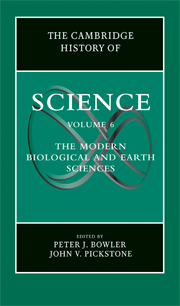Book contents
- Frontmatter
- 1 Introduction
- PART I WORKERS AND PLACES
- PART II ANALYSIS AND EXPERIMENTATION
- PART III NEW OBJECTS AND IDEAS
- 20 Plate Tectonics
- 21 Geophysics and Geochemistry
- 22 Mathematical Models
- 23 Genes
- 24 Ecosystems
- 25 Immunology
- 26 Cancer
- 27 The Brain and the Behavioral Sciences
- 28 History of Biotechnology
- PART IV SCIENCE AND CULTURE
- Index
- References
22 - Mathematical Models
from PART III - NEW OBJECTS AND IDEAS
Published online by Cambridge University Press: 28 November 2009
- Frontmatter
- 1 Introduction
- PART I WORKERS AND PLACES
- PART II ANALYSIS AND EXPERIMENTATION
- PART III NEW OBJECTS AND IDEAS
- 20 Plate Tectonics
- 21 Geophysics and Geochemistry
- 22 Mathematical Models
- 23 Genes
- 24 Ecosystems
- 25 Immunology
- 26 Cancer
- 27 The Brain and the Behavioral Sciences
- 28 History of Biotechnology
- PART IV SCIENCE AND CULTURE
- Index
- References
Summary
Early natural philosophers seeking to mathematicize nature almost certainly thought of themselves as seeing into the real foundations of the world, not as setting up models that might correspond to the observed phenomena. The language of “models” or “analogies” emerged first among late nineteenth-century physicists, and it is an interesting question (beyond the topic of this chapter) whether the explicit recognition of the modeling function marked a significant step toward the modern view of how science operates. In biology, where many at first believed the phenomena to be outside the scope of mathematical representation, the approach via models seemed to offer a way forward to those who felt that a bridge had to be built to the world of law and causality.
Mathematical modeling did not emerge as an important research strategy in the life sciences until the second decade of the twentieth century, but its origins properly lie in mid-nineteenth-century efforts to make the life sciences more like physics and in the growth of probability theory and mathematical statistics. At that time, European biologists were beginning to reject the idealist, vitalist biology of the German Naturphilosophie tradition, and several were turning toward the other physical sciences for inspiration. In particular, several young German physiologists and microbiologists advocated a reductionist biology that invoked only physico-chemical explanations, sometimes expressed as Newtonian force laws. Reductionism did not flourish everywhere immediately, but even investigators who thought that some aspects of biology were not reducible to physics or chemistry agreed that one should start by trying to make such a reduction.
- Type
- Chapter
- Information
- The Cambridge History of Science , pp. 416 - 431Publisher: Cambridge University PressPrint publication year: 2009



